I’m a graphic designer primarily, and often work straight to screen, but after having my first daughter I found myself getting back to drawing and enjoyed being more hands on. I began to draw the nature around me and form patterns with the hand drawn elements. This soon progressed to me trying lino block printing. Later down the line I released a collection of digitally printed fabrics based on my botanical lino prints, and it has gone from there.
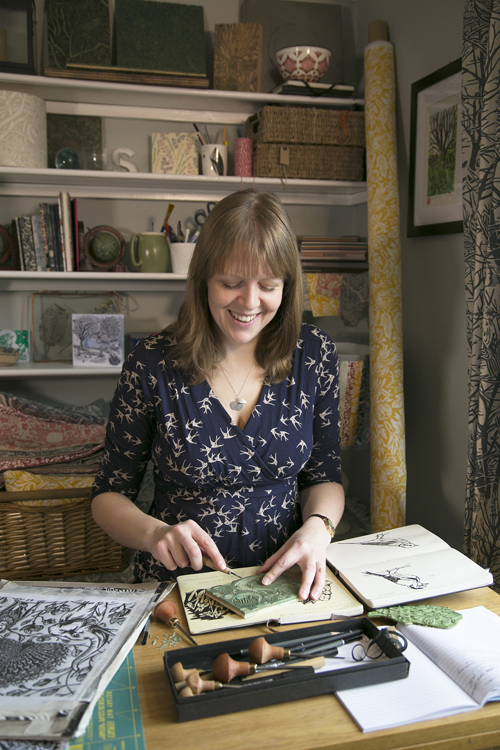
I now have three young daughters so I work flexibly around them, and still have local graphic design clients. However, my textiles have really given me the chance to follow my own creative desires again, rather than simply answering a brief. I am very grateful that a change of direction in life, caused by motherhood, made me realise how important my own personal creativity was to me. It is a big part of my identity, and it is good to have found that again.
I sell cushions, lampshades and tea towels as well as fabric for soft furnishings, printed to order by the metre.
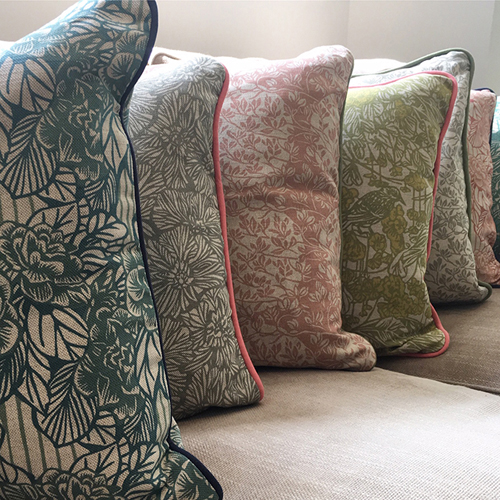
More recently I have also done some Lino prints of period buildings; ones that are personal to me, or commissions of other people’s houses. This is a bit of a treat for me, outside of my normal work, and it allows me to get really detailed and hone my printmaking skills.
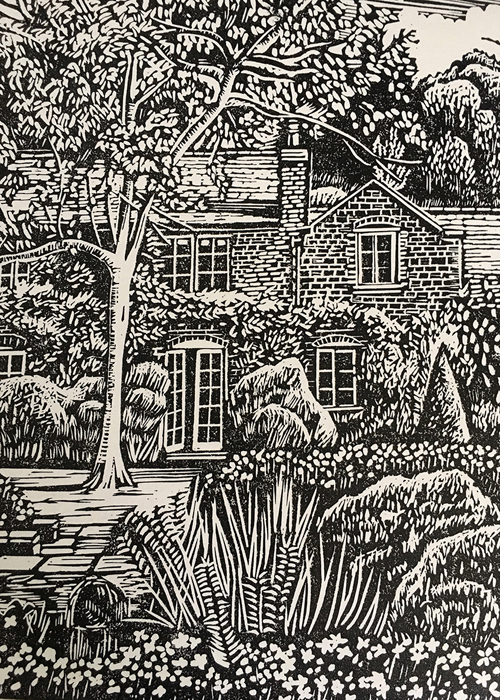
Describe your printmaking process.
I draw in black pen, referencing photos I’ve taken on my phone… mainly small details seen in my immediate outdoor surroundings. Trees, leaves, flowers, sometimes birds; any shapes I find beautiful. I scan these drawings into the computer to play with repeat patterns on screen… but then print and trace the resulting pattern tiles to lino. I really enjoy carving and like the imperfections it brings. I find it loosens up my otherwise quite controlled style of drawing.
I print my lino block in repeat, just to see what it looks like, but I find I can’t do long lengths of fabric with my current set up. To allow me to print fabric for interiors, which is where my interest lies, I scan my printed block back into photoshop and ultimately send files to my printer digitally, to be reproduced by the metre. I purposefully leave some imperfections and texture in the files… I want them to look as hand made as they can.
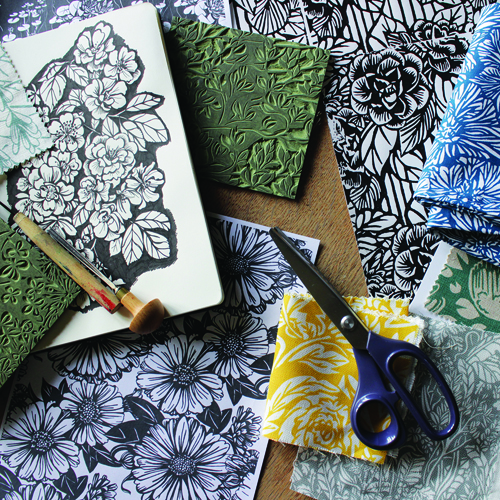
How and where did you learn to print?
My printmaking is pretty much self-taught. When I was at art college, I was largely focussed on learning the skills I needed on the computer for my degree in graphic design. I kick myself now for not making use of the amazing printmaking facilities I could have had access to. So when I started Lino printing much later, I was just following instinct and guessing at what I needed to do. There is probably lots more I could learn if I went on a more advanced course, and one day I would love to do just that. It would be great to work alongside other printmakers and to use a proper press.

Why printmaking?
I find carving Lino really satisfying, and I love learning how to create an image just by observing light and dark areas of an image. With patterns, block printing is a great way to produce a repeat, and I love the natural variations and texture you can bring to something that started off as a drawing.
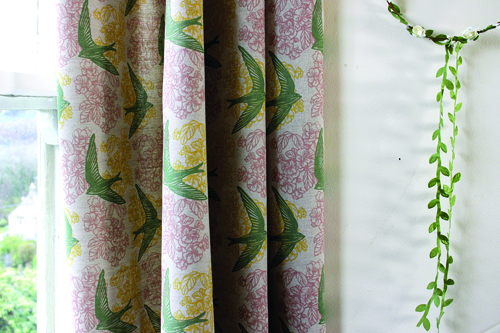
Where do you work?
Currently I work at home, in our rather overcrowded cottage near Stroud, in the Cotswolds. I often struggle with not having a proper studio yet; three little kids and my materials stored here there and everywhere makes for a tricky working environment. My partner has commented that he thinks the bathroom is the only room in the house where I don’t have some sort of work stored! But I am really lucky to work from our location as we live in a beautiful village on National Trust common land. On my doorstep I have never-ending inspiration. The Stroud Valleys also has a very high density of other artists, and opportunities to sell/exhibit work together are plentiful. Some artistic/maker friends in our village formed ‘Amberley Artisans’ with me, and we put on a Christmas Market each year. It’s a great way to connect with a wider audience and I find the connections I have made avoid me feeling too isolated when working from home. My graphic design work is also useful with that… my work life is very varied and busy.
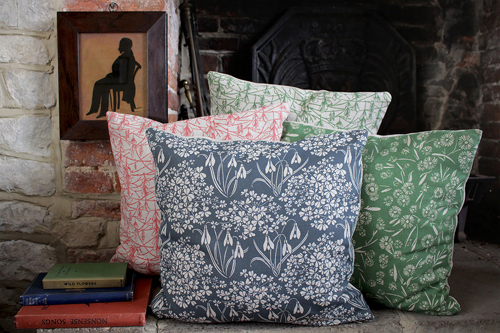
Describe a typical day in your studio.
A work day doesn’t start until I have done the school and playgroup run… and ideally that is on foot so I can sometimes take photos on my way there and back, to come back to when I get a chance. Just the fresh air is a good start to a productive day.
I must admit, that a huge proportion of my work involves no block printing at all. I have often created drawings in snatched moments over the course of many weeks, and then when I get a break in my other work, I start developing patterns and carving. Last year I carved about five blocks on my week long summer holiday… it took having a total break from the routine to give me that focus.
I often find I work like this in bursts when it comes to printmaking. Months of gathering photos or doing small drawings, suddenly comes to a head when I bring a design together and get a chance to carve. Once I have started a block I get totally addicted to the process and will do anything to make time for it. I have even carved Lino whilst parked up in a car before! I tend to print my work in the evening, when the coast is clear. I can find myself working late into the night to get results I am happy with.
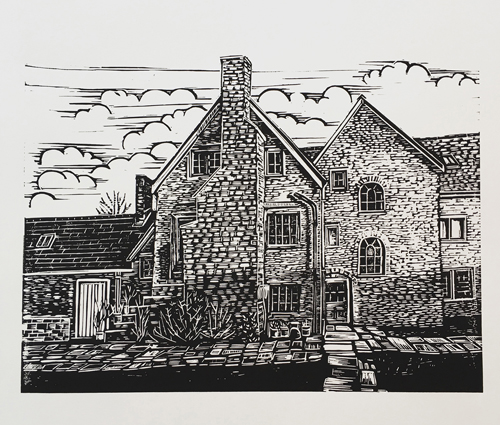
How long have you been printmaking?
I think I first picked up my first Lino tool about 6 years ago.
What inspires you?
My work almost exclusively features leaves, flowers and trees that I have seen within a mile of my house. I often feel like nature has done the hard work for me, as I see patterns everywhere I go.
I am also very inspired by Arts & Craft designers. William Morris and Voysey are my absolute heroes. But I also find the modern connectivity of Instagram is really great for me being able to surround myself in things I find beautiful. I definitely find that online community a source of encouragement and inspiration, as well as a good outlet for my work.
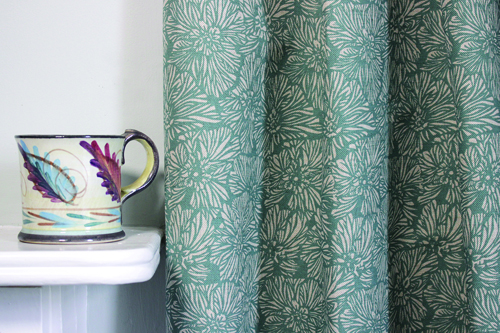
What is your favourite printmaking product?
I don’t use anything fancy, and I use a mix of traditional and soft cut Lino, and a mix of papers too. I am currently using Aqua-Linoldruck ink from Schmincke, as I really like it being water-based for easy cleaning up. I am particularly attached to a really old palette knife and a baren I had from the beginning… not because they are anything special but if you use a tool for long enough it becomes an old friend!
What have you made that you are most proud of?
There are definitely some favourite fabrics that stick out from collections I have made. ‘Rodborough Whitebeam’ is one that seems to be enduringly popular, and it was inspired by a tree just along from my house. I am just releasing a fabric called ‘Waterlily’ that I am particularly pleased with. I am also really proud of some of my Lino prints of houses… they are so detailed that it takes very little to go wrong and ruin a block. So if they turn out well it feels like a personal achievement.
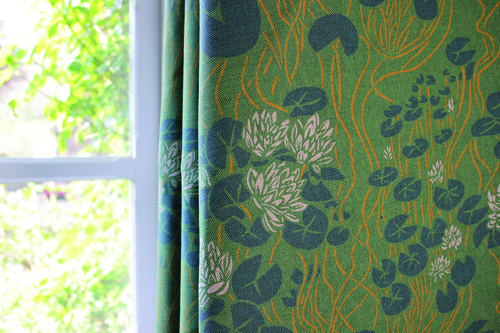
Where can we see your work? Where do you sell?
I mainly sell my fabric and some products directly from my website www.susiehetherington.co.uk but my fabrics do also sell through both shops and via interior designers. I haven’t yet released proper pattern books so it tends to work on a sample basis. Locally I sell some cushions and tea towels at my favourite museum, ‘Museum in the Park’ in Stroud. Also, I have designed the branding and packaging for my favourite client ‘Soap Folk’ (www.soapfolk.com) and these products can be found in a variety of independent shops and directly from the Soap Folk website.
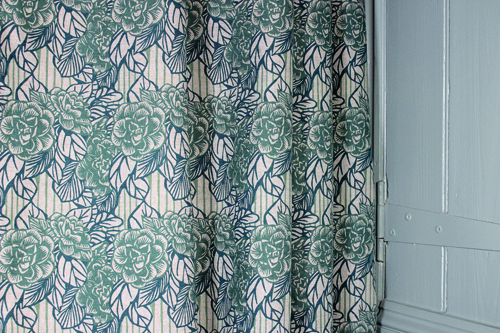
What will we be seeing from you next?
My new collection of fabrics is ready to go, and will soon be featured online and in press. Keep an eye out for it! I also have some exciting graphic design projects in the pipeline, though that side of my work is very anonymous. Perhaps I should shout about it more.
Do you have any advice for other printmakers and creatives?
I think the main advice that has helped me is that just getting on and doing is better than overthinking what you are going to do and what it will turn into. I had no idea where drawing again would take me. I had no idea what was going to happen when I picked up a Lino cutting tool for the first time. I now teach beginner Lino cutting workshops from time to time, and that is my main message; don’t worry too much about the results. You learn so much just by doing.
